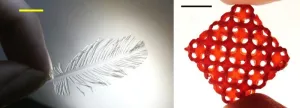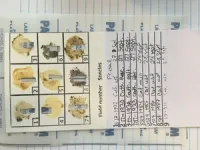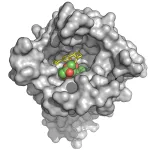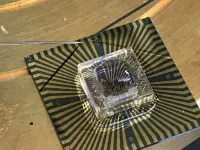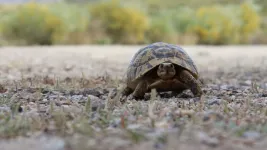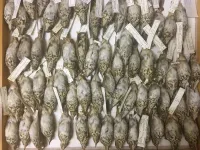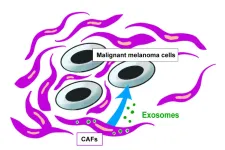(Press-News.org) INDIANAPOLIS, March 28, 2023 — The ancient art of origami is well known for transforming sheets of paper and other foldable materials into complex 3D shapes. But now, chemical engineers have extended the centuries-old practice to produce intricate shapes made of glass or other hard materials. Their thoroughly modern method, which can be combined with 3D printing, could have applications ranging from sculpture to catalysis and beyond.
The researchers will present their results today at the spring meeting of the American Chemical Society (ACS). ACS Spring 2023 is a hybrid meeting being held virtually and in-person March 26–30, and features more than 10,000 presentations on a wide range of science topics.
In earlier work, the researchers used origami and the related technique of kirigami — which combines cutting with folding — to shape soft materials made of polymers. “But we wanted to extend these techniques to glass and ceramics, which are much harder to process into complex shapes than polymers,” says Tao Xie, Ph.D., the project’s principal investigator.
Typically, glass and ceramics are shaped in a mold or are 3D printed in the desired final structure. But a mold can’t produce a complicated shape, Xie says. And although 3D printing can do so, it’s slow, and an object can be flimsy and need extra support while it’s being made. In addition, the printed item usually has a layered texture that might not be the ideal appearance. The team set out to see if they could overcome these shortcomings.
Yang Xu, a graduate student who works in Xie’s lab at Zhejiang University, devised a technique in which she mixed nanoparticles of silica — the main ingredient for making glass — into a liquid containing several compounds. Curing the mixture with ultraviolet light produced a cross-linked polycaprolactone polymer with tiny beads of silica suspended in it, like raisins in raisin bread.
Next, Xu cut, folded, twisted and pulled on sheets of this translucent polymer composite, which has mechanical properties similar to paper, to make a crane, a feather, a lacy vase and a sphere made of intertwined ribbons, among other objects. If she did this at room temperature, the composite retained its new shape fairly well throughout the remaining production steps. Xu discovered that’s because the folding and stretching process irreversibly disrupts the interface between some of the silica particles and the polymer matrix. But if it’s critical to fully retain the new shape during the subsequent steps, Xu found that the composite must be heated at about 265 F when it is folded and stretched. That permanently rearranges the links between the polymer chains, firmly fixing the new shape in place.
A subsequent heating step at more than 1,100 F removes the polycaprolactone polymer from the object and turns it opaque. After cooling, a third heating step, known as sintering, melts the silica particles together at temperatures topping 2,300 F to convert the object into clear glass with a smooth, non-layered texture. Achieving that full transparency turned out to be the project’s biggest challenge. Including more polymer in the mix made the objects easier to fold but reduced their final transparency, explains Xu, who is presenting the work at the meeting. She ultimately found the right concentrations of polymer and silica to successfully compromise between those competing priorities.
In her latest work, Xu is extending the method beyond glass to ceramics, replacing the silica with substances such as zirconium dioxide and titanium dioxide. Whereas glass is brittle and inert, these compounds open up the possibility of producing “functional” objects, such as materials that are less fragile than glass or that have catalytic properties.
The group is also experimenting with a combination of kirigami and 3D printing to make even more complex shapes. “When you fold a piece of paper, the level of complexity is somewhat limited, and 3D printing is kind of slow,” Xie says. “So we wanted to see if we could combine these two techniques to take advantage of their attractive attributes. That would give us the freedom to make almost any shaped part.”
In the catalyst field, Xie notes, people use 3D printing to make ceramic structures perforated with microscopic channels, which increase a catalyst’s exposed surface area. Xu’s method could enable more intricate designs for such applications, and as a test case, she has printed a pierced 3D lattice made of the silica-polymer composite (red structure in accompanying image).
Xu notes that her process could be automated for large-scale manufacturing. She and Xie hope the ceramics and artistic communities will learn about the work and apply it in catalyst and sculpture design, as well as other purposes the researchers haven’t even thought of yet.
The researchers acknowledge support and funding from the National Natural Science Foundation of China.
A recorded media briefing on this topic will be posted Tuesday, March 28, by 10 a.m. Eastern time at www.acs.org/acsspring2023briefings. Reporters can request access to media briefings during the embargo period by contacting newsroom@acs.org.
For health and safety information for ACS Spring 2023, please visit the FAQ webpage.
The American Chemical Society (ACS) is a nonprofit organization chartered by the U.S. Congress. ACS’ mission is to advance the broader chemistry enterprise and its practitioners for the benefit of Earth and all its people. The Society is a global leader in promoting excellence in science education and providing access to chemistry-related information and research through its multiple research solutions, peer-reviewed journals, scientific conferences, eBooks and weekly news periodical Chemical & Engineering News. ACS journals are among the most cited, most trusted and most read within the scientific literature; however, ACS itself does not conduct chemical research. As a leader in scientific information solutions, its CAS division partners with global innovators to accelerate breakthroughs by curating, connecting and analyzing the world’s scientific knowledge. ACS’ main offices are in Washington, D.C., and Columbus, Ohio.
To automatically receive news releases from the American Chemical Society, contact newsroom@acs.org.
Note to journalists: Please report that this research was presented at a meeting of the American Chemical Society.
Follow us: Twitter | Facebook | LinkedIn | Instagram
Title
Transparent origami glass
Abstract
The art of origami has emerged as an engineering tool with ever increasing potential, but the technique is typically limited to soft and deformable materials. Glass is indispensable in many applications, but its processing options are limited by its brittle nature and the requirement to achieve optical transparency. We report a strategy that allows making three dimensional transparent glass with origami techniques. Our process starts from a dynamic covalent polymer matrix with homogeneously dispersed silica nanoparticles. Particle cavitation and dynamic bond exchange offer two complementary plasticity mechanisms that allow the nanocomposite to be permanently folded into designable geometries. Further pyrolysis and sintering convert it into transparent three dimensional glass. Our method expands the scope of glass shaping and potentially opens up its utilities in unexplored territories.
END
Modern origami method creates glass shapes by folding
2023-03-28
ELSE PRESS RELEASES FROM THIS DATE:
Marijuana-derived compounds could reverse opioid overdoses
2023-03-28
INDIANAPOLIS, March 28, 2023 — There’s been a recent push in the U.S. to make naloxone — a fast-acting opioid antidote — available without a prescription. This medication has saved lives, but it’s less effective against powerful synthetic opioids, such as fentanyl. In an interesting twist, researchers are now looking to cannabidiol (CBD), a component of marijuana, as a possible alternative to the popular antidote. Today, a team reports compounds based on CBD that reduce fentanyl binding and boost the effects of naloxone.
The researchers will present their results at the spring meeting of the American Chemical Society (ACS). ...
Is it COVID-19 or the flu? New sensor could tell you in 10 seconds
2023-03-28
INDIANAPOLIS, March 28, 2023 — Have a cough, sore throat and congestion? Any number of respiratory viruses could be responsible. Conventional tests can identify certain likely culprits by relying on chemical reactions, but some researchers want to swap chemistry for electrical changes sensed by nanomaterials. Today, scientists report using a single-atom-thick nanomaterial to build a device that can simultaneously detect the presence of the viruses that cause COVID-19 and the flu — at much lower levels and much more quickly than conventional tests for either.
The researchers will present their results at the spring meeting ...
Shedding pounds may benefit your heart — even if some weight is regained
2023-03-28
Research Highlights:
Weight loss was associated with decreased risk factors for cardiovascular disease and Type 2 diabetes for at least five years — even if some weight was regained, according to a review of research on behavioral weight loss programs.
People who lost weight through an intensive behavioral weight loss program had lower systolic blood pressure levels, total cholesterol-to-good cholesterol ratio and HbA1c levels (a diabetes marker), when compared to people who did not participate in a program or participated in a lower-intensity behavioral program.
Embargoed ...
Turtles and crocodiles with unique characteristics are more likely to go extinct
2023-03-28
New research led by the University of Oxford has revealed that the most endangered turtle and crocodile species are those that are most unique. Their loss could have widespread impacts on the ecosystems they live in, since they carry out critical processes important for many other species.
Turtles and crocodiles are two of the world's most endangered animal groups, with approximately half of species globally threatened (International Union for Conservation of Nature, IUCN). Greater understanding on which species are most threatened and why is urgently needed to inform conservation efforts to save them.
In a new study led by researchers at the Department of Biology, ...
A final present from birds killed in window collisions: poop that reveals their microbiomes
2023-03-28
Every year, millions of birds crash into windows in cities along their migratory path. For decades, scientists and volunteers have risen at dawn in spring and fall to collect the fallen birds, rehabilitating the injured and documenting the dead. The bodies of the birds killed in these collisions are a treasure trove of scientific information, especially when compared year after year. A new study in the journal Molecular Ecology makes use of these specimens to help understand the relationship between birds and the microbes living in their guts—which appears ...
ISTA welcomes first journalists in residence
2023-03-28
Understanding of and trust in science and scientists are dangerously low, and initial studies suggest that a general lack of interest in science is even more of a problem than skepticism in Austria. A key partner in alleviating this mistrust, clearing up misunderstandings, and building up enthusiasm for science must be the media in general and science journalists in particular. However, these journalists need access to the information as well as the resources to work independently and give full flight to their curiosity and creativity. To work towards these goals and promote excellent science journalism, ISTA initiated a program to host journalists for two-to-four-month ...
Candidate found to inhibit malignant melanoma growth
2023-03-28
Malignant melanoma is a relatively aggressive type of skin cancer. When detected early, it is usually treatable by surgical resection only, but metastases develop often spreading to distant areas. Currently, tumor thickness and the presence of ulceration are some of the known prognostic factors used as indicators of malignant melanoma. Therefore, the discovery of valuable markers to assess the malignant potential of melanoma more accurately may be necessary to develop appropriate treatments.
Cross talk between cancer cells and surrounding stromal cells is ...
New form of omega-3 could prevent visual decline with Alzheimer’s disease
2023-03-28
For the first time, researchers have developed a form of the omega-3 fatty acid docosahexaenoic acid (DHA) that is capable of crossing into the eye’s retina to ward off visual declines related to Alzheimer’s disease, diabetes and other disorders.
The DHA found in fish oil capsules and other supplements is typically in a form called triacylglycerol (TAG) DHA. Although TAG-DHA has benefits in other parts of the body, it does not reach the eyes because it cannot travel from the bloodstream into the retina. For the study, ...
Less ‘risky’ sex of early pandemic still evident year after first lockdown in Britain
2023-03-28
The lower prevalence of ‘risky’ sex—with multiple or new partners without using condoms—which occurred during the early stages of the COVID-19 pandemic, was still evident a year after Britain’s first lockdown, reveal the results of a major national survey, published online in the journal Sexually Transmitted Infections.
While there were fewer reported unplanned pregnancies and abortions than indicated by a comparable survey a decade earlier, there were significantly higher prevailing levels of sexual dissatisfaction and worries ...
Allergic (atopic) asthma/eczema linked to heightened risk of osteoarthritis
2023-03-28
People with atopic (allergic) diseases like asthma or eczema may be at heightened risk of the painful and often disabling joint condition, osteoarthritis, finds research published online in the Annals of the Rheumatic Diseases.
Drugs used to dampen down the physiological prompts for allergic reactions in the body may help lessen this risk, suggest the researchers.
Osteoarthritis is the most common form of arthritis. But despite the high prevalence, substantial costs, and debilitating impact of the disease, there is as yet no effective ...
